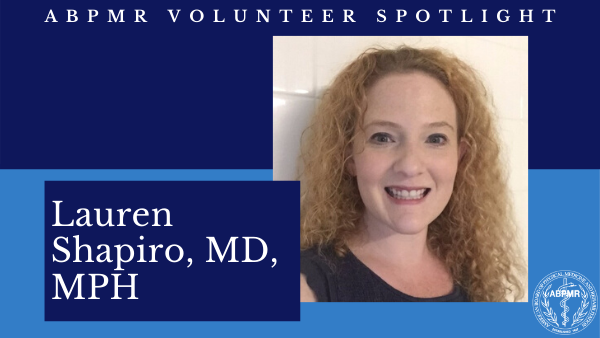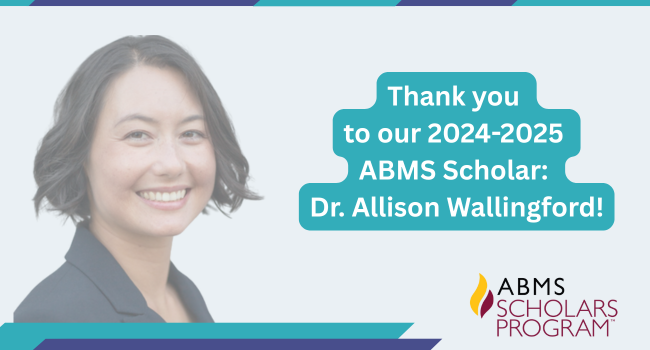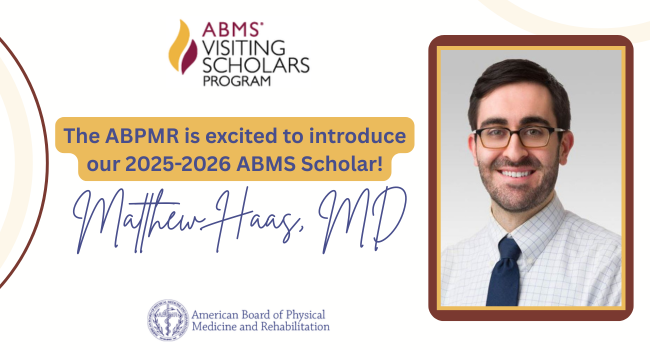Physician Features
Volunteer Spotlight: Lauren Shapiro, MD, MPH

Lauren Shapiro, MD, MPH, is the March Volunteer Spotlight feature! The ABPMR Volunteer Spotlight highlights ABPMR volunteers and their work that helps fulfill our mission of quality patient care in PM&R. Thank you to all our volunteers and the unique ways you contribute to the ABPMR and the field of PM&R!
Dr. Shapiro serves as an item writer for LA-PM&R (longitudinal assessment for PM&R), and will be an oral examiner for the first time this May. She graduated medical school from SUNY- Stony Brook School of Medicine in New York, and completed her residency at the McGaw Medical Center, Northwestern University in Chicago (at what was formerly the Rehabilitation Institute of Chicago). She received her primary certification in 2009 and her brain injury medicine certification in 2014.
Dr. Shapiro is currently the stroke medical director at the Christine E. Lynn Rehabilitation Center for the Miami Project to Cure Paralysis at UHealth/Jackson Memorial Hospital; she is also assistant professor of clinical in the Department of PM&R at the University Miami School of Medicine, and serves as vice-chair for quality, safety, and compliance there.
In our conversation, Dr. Shapiro spoke about her interest in item writing, why she sees volunteering as essential for PM&R, and how her cats have kept her pandemic hobby alive.
How did you get started in PM&R?
I went to a medical school that didn’t have much exposure to PM&R and I found myself drawn to both neurology and rheumatology. During my third year of medical school, not entirely sure which specialty to pursue, I started asking all my attendings on my rotations what specialty they would have done if they had to do things over. A lot of them mentioned PM&R, so I arranged for a rotation early on in my fourth year. I really enjoyed it, and it's fortunate I stumbled on it that way!
After medical school, where did your career start?
I stayed at my medical school for an additional year for an internship in internal medicine, then did my residency in PM&R at what was then the Rehabilitation Institute of Chicago. From there, I began working right away as a general rehabilitation physician. I became board certified in PM&R in 2009 and took the Brain Injury Medicine Examination to become board certified in that in 2014.
You went to medical school in New York, did your residency in Chicago, and now you’re in Miami. How did you end up there?
I started working here in 2016. I started my career in academics and then worked for a private practice in the northern Virginia area for about five years. During that time, I also earned my master's degree in public health, and ultimately decided I wanted to return to an academic practice. I have a lot of family here in South Florida so took the position here!
What does a day in your practice look like?
I have rounds on an inpatient rehabilitation unit every morning with a second-year resident, and I do a number of clinics each week that mostly focus on neurological rehabilitation. We have trainees at all different levels who come rotate or shadow. Our first brain injury medicine fellow will be starting in July.
When did your volunteer work with the ABPMR begin?
Someone had posted about a volunteer workshop they were going to run at the start of an AAPM&R [American Academy of Physical Medicine and Rehabilitation] meeting for anyone who was interested. I flew in a little early for the meeting and decided to attend the workshop! I’ve been an item writer for LA-PM&R for three years.
What has your experience been item writing for LAPM&R, and do you think you'll step into other volunteer roles?
I’m going to be an oral examiner for the first time in May! It’s been very good to be an item writer; I actually write for a different domain than what is my primary practice area. It forces me to stay up to date with the field and read more on other topics that are still relevant to my area, but that I don’t encounter every day. I like that I can do item writing in little pieces instead of devoting a big block of time— I write in the bits of time I have between rounds and my clinic. It’s very manageable.
What keeps you coming back to volunteer and take on new roles like becoming an examiner?
I think the work of the board is extraordinarily important for our profession and maintaining high-quality standards for rehabilitation physicians who care for patients. We can all help in the work that the ABPMR does, and it doesn't take a major amount of time.
You mentioned that item writing keeps you updated with what’s new in the field— what else does volunteering teach you?
It’s certainly been a reminder as to the breadth of our specialty. Topics have come up that I don’t give much thought to in my day-to-day work, but then you start thinking about how important those topics are within the greater field. When I look at the outline to see what subjects appear on the longitudinal assessment, it’s a huge reminder about all the different areas people in our specialty are working in.
Volunteering to you is important because it upholds quality patient care in the field of PM&R. If you were to recommend volunteering to a diplomate, what else would you say about why it’s valuable?
It’s a way to ensure that the next generation of physicians are meeting the same high-quality expectations that patients have of PM&R physicians. In volunteering, we can help ensure that there continues to be quality standards that define what it means to be a rehabilitation physician.
Do you have a fun memory or experience from serving as an item writer?
I laughed the first time I had to answer one of my own questions for LA-PM&R. I wasn’t sure if I answered my own question right!
What do you do outside of work?
My pandemic hobby has been indoor gardening and I’m not very good at it. My tomato plant has been growing for over 200 days and I’ve had five cherry tomatoes. I thought it was a good idea to plant all these things so I wouldn’t have to go to the grocery store as often. My planter even came with a light that goes off when it needs to be watered, but I ignore the light! Fortunately, I have two cats and one really likes the plants, so he’ll yell at me to water them. Hopefully when the world opens back up I can get back to things that are a little more enjoyable like traveling!

Dr. Shapiro's cat Chompers, protector of the tomato plants
Thank you, Dr. Shapiro, for your passion for volunteering and your work with the ABPMR. To all the ABPMR volunteers who have dedicated so much of their time and effort to the field of PM&R: thank you!



